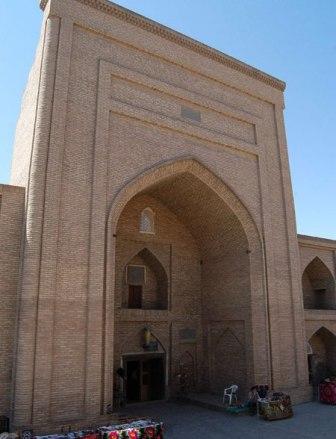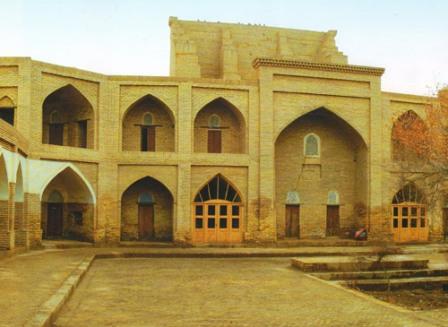|
Category
|
Shirgazi Khan Madrassah
Madrassas as a sign of reverence for the patron saint of Khiva - Pahlavan-Mahmud had been built strictly to the south of his tomb. Madrasah is located in the breakage of the ancient city wall. For this reason, as well as due to natural subsidence of the soil, the entrance to the madrassa is below the road level by 2 meters. One-story building madrassas, except for a two-story entrance part. Madrasah includes four-aiwan yard range vestibule rooms and lecture hall ("darskhona"). This madrasa education received many well-known representatives of the Khiva Khanate. Madrassah Shirgazi Khan glorified by the fact that here in the middle of the XVIII century, studied the outstanding Turkmen poet Makhtumkuli. Apparently, the charm of poetry Pahlavan-Mahmud contributed to the early awakening of poetic talent in the young Turkmen. He remembered with gratitude in his poem "Farewell to the madrassas Shirgazi" the years spent within its walls: Now I know that black and white that, Who is a friend who is my enemy, what is good, that evil. The Koran and many other books in my brain has become ... Farewell, home of science, fine Shirgazi!
It scored a key inspiration in me, sparkling. I will be angry, denouncing vices dirt Spiritual with you, I did not tear us ... Farewell, home of science, fine Shirgazi! According to legend, madrassas built slaves captured after a successful campaign of Shirgazi Khan in Khorasan (northeastern Iran). Together with the booty he led 5000 captives. Shirgazi Khan has promised to release the prisoners after the construction of madrassas will be completed. Masonry was performed in a single year, but Shirgazi Khan indefinitely prolonged the end of the building. Then the enraged prisoners killed Khan in an unfinished madrassah. Mausoleum Shirgazi Khan attached to the western corner of the main facade of madrassas. Plaques installed in the madrassas, and representing a "waqf-nama" (land records) contain information on land reserved for madrassas, as well as data on the time of its construction, the distribution of income among the servants of the school and some of the rules of their conduct.
House Rules related not only to students who "... if (it) without cause for two months leave (madrassas), it may take another hujra (student) ...", but also a teacher - "... Mudaris (“teacher”), who left (his hujra) on week, owes absolutely nothing ... ". Despite a major renovation in the late XIX century, madrasas strongly affected by time. The rush during the production of construction and lack of skilled craftsmen have affected the quality of the clutches and are reflected in the primitive structures of arches and vaults. On the facade there are no brace masonry or multicolored majolica. The interiors of large and small facilities are also very ascetic. |
 To the south of the mausoleum of Pahlavan-Mahmud, in the center of Ichan-Kala is located the oldest madrassah in Khiva - madrassas Shirgazi Khan. It is built in the first quarter of XVIII century in the reign of Shirgazi Khan (1715-1728).
To the south of the mausoleum of Pahlavan-Mahmud, in the center of Ichan-Kala is located the oldest madrassah in Khiva - madrassas Shirgazi Khan. It is built in the first quarter of XVIII century in the reign of Shirgazi Khan (1715-1728). This ancient Khiva Madrassah was the richest in the city. Every year it received from the land allotted to him a lot of wheat, rice and sorghum. Trustee waqf - "mutavalli", according to Waqf-name followed the distribution of incomes between teachers, servants and students.
This ancient Khiva Madrassah was the richest in the city. Every year it received from the land allotted to him a lot of wheat, rice and sorghum. Trustee waqf - "mutavalli", according to Waqf-name followed the distribution of incomes between teachers, servants and students.














